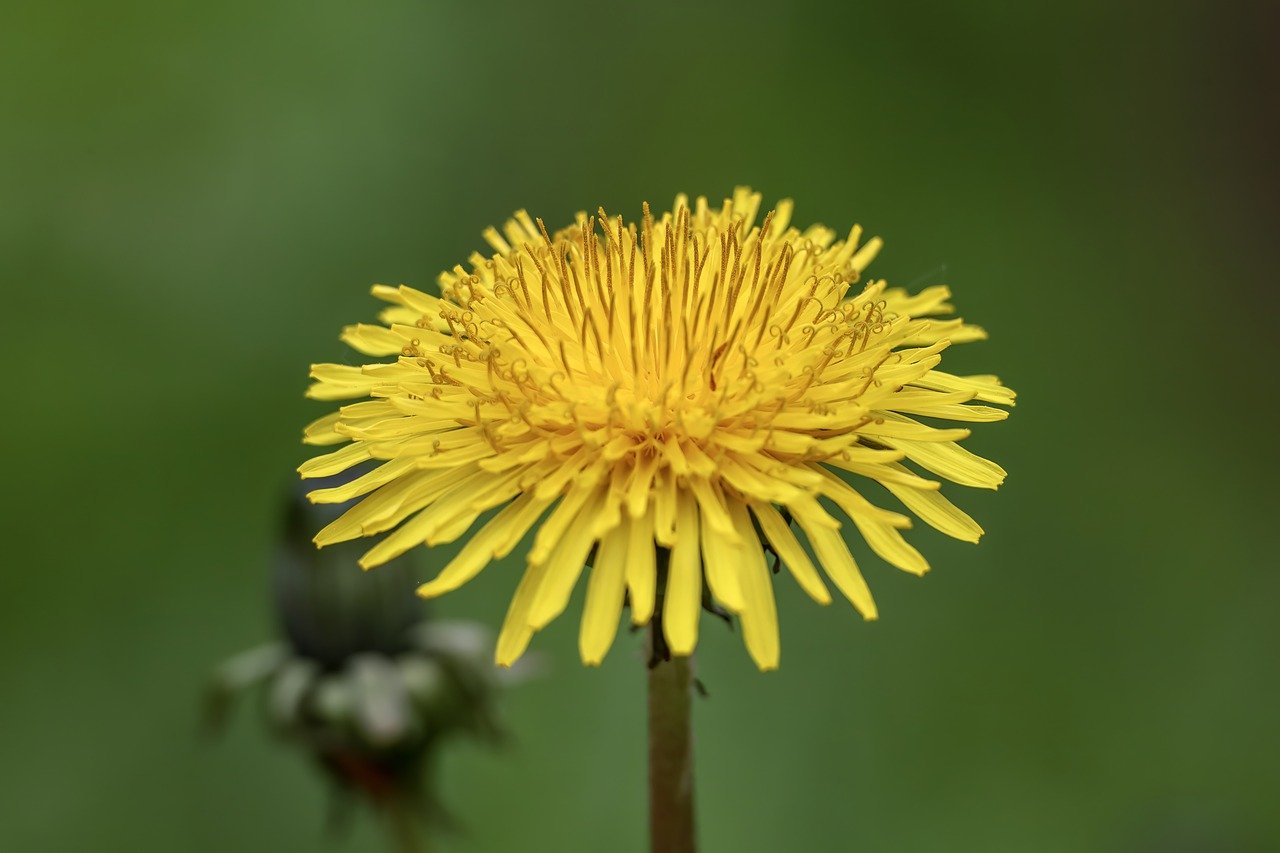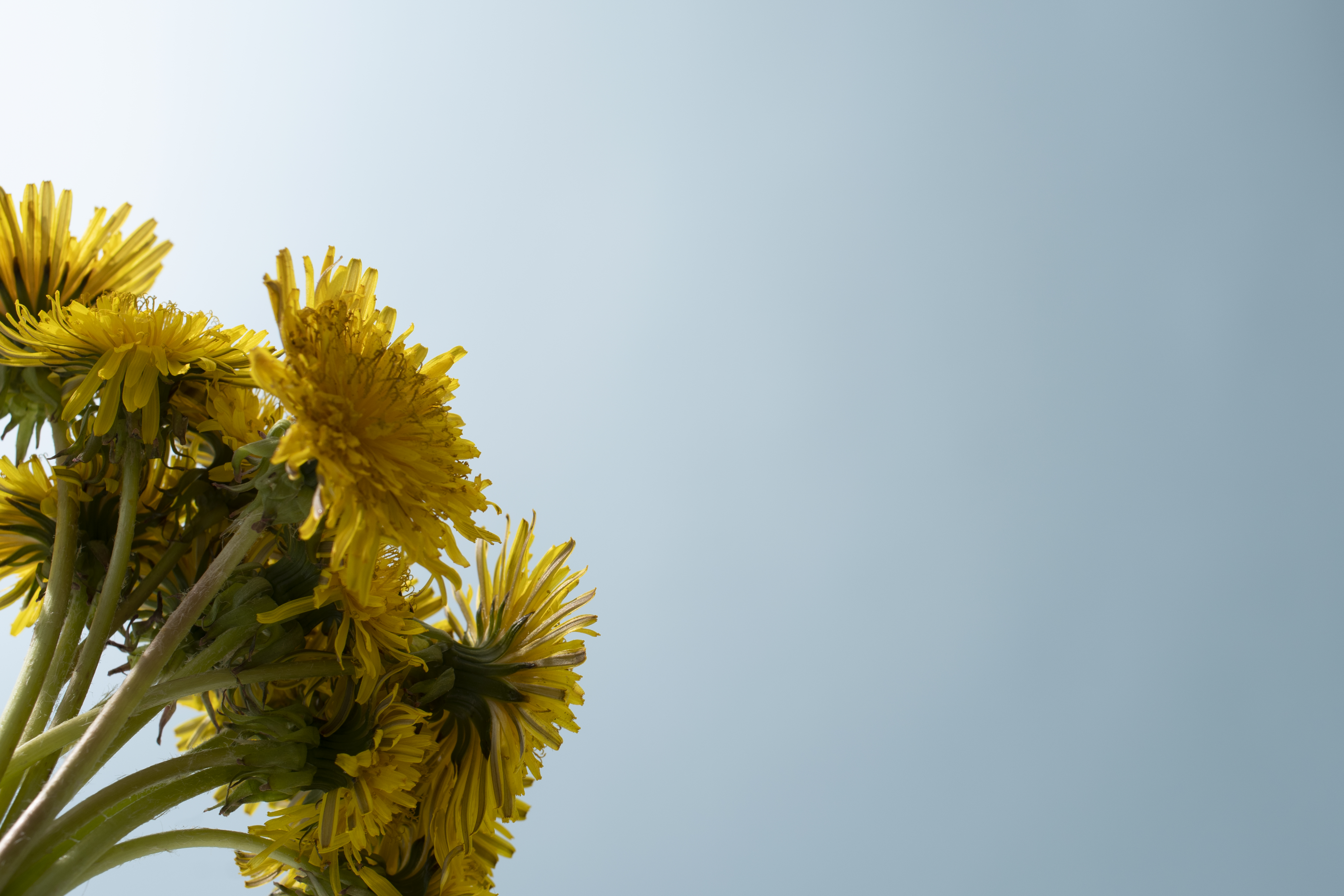Dandelion is a small perennial plant from the aster family – Asteraceae. Dandelions occur commonly in almost all of Europe. In many countries, it is considered a challenging weed to eradicate, and it can often be in parks, lawns, old buildings, and pastures. A meadow full of yellow dandelion flowers is associated with spring.
This plant has been widely used in herbal medicine. Its parts and extracts were used to treat skin lesions like warts and warts, reduce discoloration and acne, and boost the immune system during minor infections.

The dandelion![]() produces a small achene surrounded by down, which helps in seed dispersal. Because it has a single stem, it is often mistaken for the common milkweed Sonchus arvensis.
produces a small achene surrounded by down, which helps in seed dispersal. Because it has a single stem, it is often mistaken for the common milkweed Sonchus arvensis.
The dandelion has lanceolate, coarsely, laterally serrated leaves that form a rosette. It grows from a vertical, cylindrical, fleshy root. In early spring, shoots emerge from the rosette, bearing flower baskets with intensely yellow ligulate flowers – the dandelion blooms from April to July and sometimes again in the autumn. The entire plant contains milky juice, which can stain the skin but also has wart and verruca-removing properties.
This plant has remarkable healing properties, and the dandelion root – Taraxaci radix – or dandelion herb with root – Taraxaci radix cum herba – is used as herbal raw material. The raw materials are collected in late autumn and dried at an appropriate temperature.
It's important to note that dandelion and milkweed are often confused, but they are two distinct plants. In botanical nomenclature, “Milkweed” only refers to plants of the Sonchus genus.
The dandelion is both edible and medicinal. It usually has several stems growing very close to the ground, each bearing a single flower and no leaves. It forms characteristic fruit heads called dandelions and a leaf rosette at the ground. On the other hand, milkweed is considered a weed and has one long stem from which side shoots and small leaves branch off.
Dandelion is used in home remedies and medicine. Products such as root decoction, root wine, leaf juice, flower syrup, and herb drops are utilized to treat various conditions related to liver damage and reduced bile secretion. It is supposed to be particularly beneficial during recovery after viral hepatitis, post-biliary tract surgery, cases of bile stasis in the gallbladder, and for those at risk of gallstones.
Dandelion products may also be recommended for impaired renal glomeruli function, reduced daily urine output, and edema caused by circulatory and renal disorders. Additionally, they are used as supplements in the treatment of rheumatism, gout, obesity, acne, pre-diabetes, and early diabetes.
Dandelion is externally used for cosmetic baths, and fresh milky juice is applied for compresses for warts and condyloma acuminate. The herb's flowers help treat chronic inflammations of the oral cavity, throat, and bronchi.
The group of phenolic acids![]() , which include mono caffeoyl tartaric acid, chlorogenic acid, and chicory acid, is responsible for the healing properties of dandelion. In addition, sesquiterpene lactones present in the extracts are significant for the action of the raw material. Dandelion root is also a good source of mineral salts, inulin phytosterols, and triterpenes. Other substances found in extracts from the root, flowers, or leaves also include β-amyrin, taraxerol, stigmasterine, and vitamin A, the concentration of which is very high.
, which include mono caffeoyl tartaric acid, chlorogenic acid, and chicory acid, is responsible for the healing properties of dandelion. In addition, sesquiterpene lactones present in the extracts are significant for the action of the raw material. Dandelion root is also a good source of mineral salts, inulin phytosterols, and triterpenes. Other substances found in extracts from the root, flowers, or leaves also include β-amyrin, taraxerol, stigmasterine, and vitamin A, the concentration of which is very high.
Phenolic acids present in the extracts increase the production and flow of bile (reducing its stasis) to the initial sections of the digestive tract, thus facilitating the digestion of fats. Compounds contained in the plant (sesquiterpene lactones contained in the milky sap) can also act locally, causing skin diseases. It contains inulin.
The anti-inflammatory effects![]() of dandelion allow the use of extracts from this plant to alleviate acne lesions. In addition, animal studies have confirmed that dandelion extracts limit the development of inflammation in acute pneumonia, tracheitis, and pancreatitis. Substances contained in dandelion extracts reduced the level of interleukin six and the concentration of tumor necrosis factor—TNF-α.
of dandelion allow the use of extracts from this plant to alleviate acne lesions. In addition, animal studies have confirmed that dandelion extracts limit the development of inflammation in acute pneumonia, tracheitis, and pancreatitis. Substances contained in dandelion extracts reduced the level of interleukin six and the concentration of tumor necrosis factor—TNF-α.
It is also being studied whether dandelion has antibacterial properties![]() . The bactericidal effect is probably due to saponins, tannins, phytosterols, and triterpenes. Dandelion extracts have been found to inhibit the growth of Enterococcus faecalis, Escherichia coli, Staphylococcus aureus, Salmonella typhi, and Bacillus cereus.
. The bactericidal effect is probably due to saponins, tannins, phytosterols, and triterpenes. Dandelion extracts have been found to inhibit the growth of Enterococcus faecalis, Escherichia coli, Staphylococcus aureus, Salmonella typhi, and Bacillus cereus.
Dandelion roots and herbs can be used to make a decoction or infusion, which aids digestion![]() and has a mild diuretic effect
and has a mild diuretic effect![]() .
.

Dandelion is an entirely edible medicinal plant. It is often used in the kitchen in many ways: young leaves (older ones may taste bitter) are added to salads and soups, buds are fried in dough, and flowers are used to make wines, tinctures, and syrups.
Dandelion tea has many beneficial properties, including for the digestive system. In the previous era, wine made from dandelion flowers and roots was often recommended. Currently, dandelion syrup is among natural medicine recipes as a digestive, detoxifying, or stimulating the bile production by the liver. The syrup supports therapy for upper respiratory tract infections, sore throat, and cough.
Due to the profile of action of dandelion, caution![]() should be exercised when used by individuals treated with diuretics, anticoagulants, and gastric acid-neutralizing drugs.
should be exercised when used by individuals treated with diuretics, anticoagulants, and gastric acid-neutralizing drugs.
People suffering from biliary tract diseases, cholelithiasis, stomach and duodenal ulcers, severe kidney diseases, and electrolyte disorders should avoid using dandelion without consulting a doctor.
In some cases, taking dandelion may result in some side effects. Because it is a bitter plant that stimulates the production of digestive juices, it can increase the symptoms of hyperacidity, heartburn, indigestion, nausea, and mild diarrhea. Dandelion pollen is a potential allergen that sometimes causes contact allergies manifested by skin lesions and may cause cross-allergies with pollen from other Asteraceae family plants.
Dandelion roots are best dug up in October and November when they are the least fibrous. The stems are best collected during flowering. Leaves are best collected before flowering, and flowers are best collected in May because they are the ripest and do not have the characteristic bitter aftertaste. They should be collected on a sunny day before noon, when the flower is most open.
After thorough washing, it is cut lengthwise into strips and dried in a shaded and airy place at ambient temperature or in a drying room, but so as not to exceed 30 °C (according to some sources, dandelion roots are dried at a temperature of 40–50 °C). The herb and flower are dried in similar conditions.
Dried flowers can be stored for about half a year, while fresh ones should be processed quickly according to your preferences before the plant withers.
Dandelion has multiple uses.
Dandelion cream can be used both internally and externally. It can help with various skin ailments and diseases. Due to its UVB protection![]() , moisturizing, regenerating, and irritation-soothing properties, it is often used in creams. Importantly, it is not recommended to make such a cream because then it is easy to exceed the permissible dose of this plant, which can have negative effects.
, moisturizing, regenerating, and irritation-soothing properties, it is often used in creams. Importantly, it is not recommended to make such a cream because then it is easy to exceed the permissible dose of this plant, which can have negative effects.
Dandelion root tea has delicate properties, supporting digestion, cleansing the blood, and acting as a diuretic. To prepare dandelion root tea, pour a cup of boiling water over two teaspoons of dried root and steep for 15 minutes.
There are two methods for preparing tea![]() from dandelion root and leaves.
from dandelion root and leaves.
Boil 250 ml of water, add two tablespoons of cleaned and chopped fresh root, and boil. Remove from heat and add two tablespoons of chopped, freshly picked leaves. Steep for about 40 minutes and strain. This infusion can be consumed in two glasses a day.
Steep a handful of freshly picked flowers in 250 ml hot water for about 20 minutes. Drink one glass of the infusion twice a day.

Dandelion oil, or macerate, can be prepared using the plant's flowers. Please put them in a jar to a height of 8 cm and then cover them with olive oil 4 cm above. The jar must be closed and boiled for about 3 hours. Only then can it be set aside for a day and strained. It is worth adding it to meals or applying it to the skin.
Dandelion syrup![]() possesses antitussive, cleansing, and anti-atherosclerotic properties. The dandelion syrup contains:
possesses antitussive, cleansing, and anti-atherosclerotic properties. The dandelion syrup contains:
Dandelion syrup helps with respiratory and urinary tract infections, improves digestion, supports the treatment of liver and gallbladder diseases, has anti-atherosclerotic properties, relieves skin ailments, and accelerates wound healing. However, due to its high sugar content, it is not recommended for people suffering from stomach ulcers and hyperacidity. For diabetics, an infusion of dandelion flowers is preferred.
Collect fresh flowers from a sunny meadow away from urban areas. A portion (about 400 pieces) of flowers is plucked of the yellow petals because only these can be used for syrup.
Separate the dandelion flowers from the rest of the plant, place them in a pot, and pour water over them. Boil them for about 10 minutes on low heat. After a day, put the vessel in a cool place, strain the broth, and add sugar and lemon juice.
After mixing and combining the ingredients, boil again for about 3 hours until the liquid is consistent with honey. Pour the ready dandelion syrup into previously prepared jars. Dandelion syrup prepared in this way will be useful for several months.
It is possible and does not require any particular technique. Tear off the yellow petals (the greenish ones may be too bitter) and arrange them in layers in a sterilized jar, alternating with sugar. After pouring water and screwing on the lid, the syrup prepared in this way should be ready after a week.
You can fill the whole thing with spirit to make a tincture or wine.
The honey yield of dandelions reaches up to 20 kg/ha. Individual hives can gain up to 3-4 kg per day during intensive flowering (i.e., for about eight days). Nectar is collected more efficiently by bees flying around flowers at lower temperatures, i.e., by long-tongued hybrids and the Caucasian race. In insufficiently warm, sunny weather (which often happens in spring), nectar production is poor. In such conditions, bees collect a lot of pollen and little nectar from flowers.
Flowers are inaccessible to bees from the afternoon when the baskets close and during rain when they do not open. Also, inflorescences, which are the habitat of many beetles, are not visited by bees. Dandelion pollen has a standard nutritional value for bees. The nectar and pollen from dandelion has a characteristic orange color. Dandelion is the main honey plant in some areas, especially mountainous ones.
The fresh plant is a valuable food for farm animals, with dandelion being particularly eagerly eaten by rabbits and poultry. In the classification of fodder plants, it is classified as a fodder herb, but despite its potential, it is often not only unused but also treated as a weed. Meanwhile, dandelion feed is considered valuable, especially in early use. It is nutritious, easily digestible and dietary.
The dandelion herb improves the taste of feed, regulates digestion, and prevents excessive gas and colic in animals. The dandelion's share in hay is usually small due to its high water content and low growth. Dandelion is also valued in pastures due to its drought resistance and filling gaps in the growth of valuable grasses.